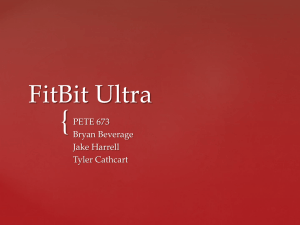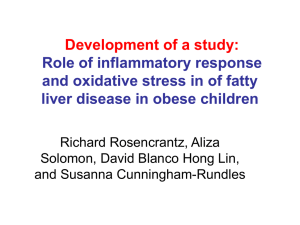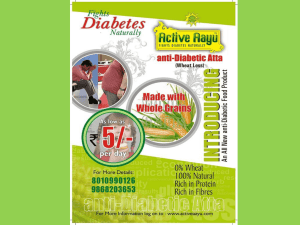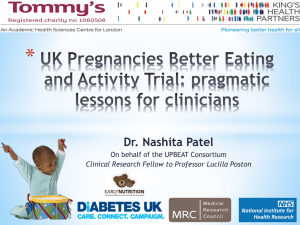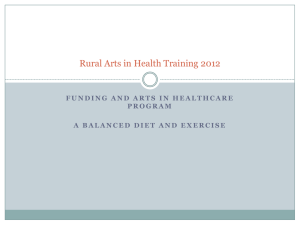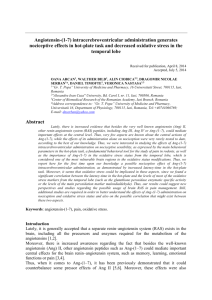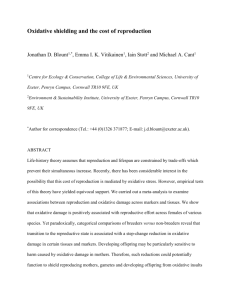Oxidative stress and caloric restriction
advertisement
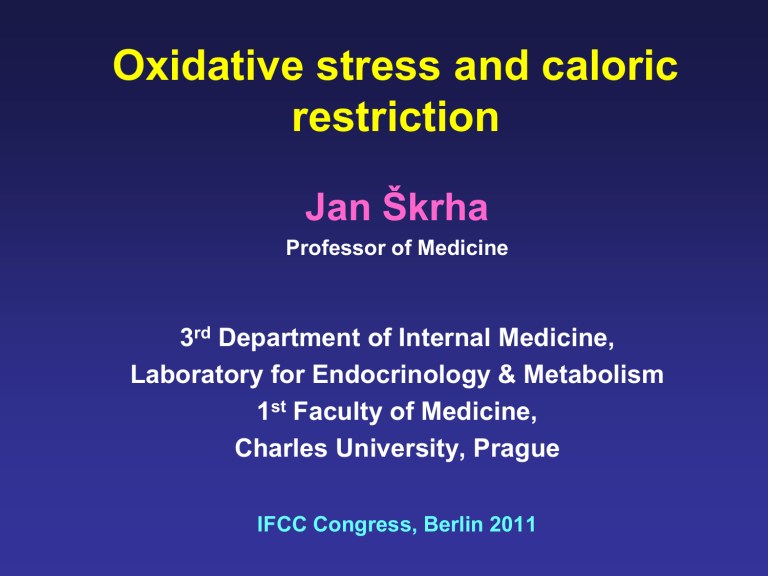
Oxidative stress and caloric restriction Jan Škrha Professor of Medicine 3rd Department of Internal Medicine, Laboratory for Endocrinology & Metabolism 1st Faculty of Medicine, Charles University, Prague IFCC Congress, Berlin 2011 OBESITY AND CONSEQUENCES Overeating Weight increase Higher concentration of circulating FFA Insulin resistance Hyperinzulinemia ROS FFA – GENERATOR OF INSULIN RESISTANCE AND OXIDATIVE STRESS FFA Insulin IRS-1 phosphoryl. serine/threonine IRS-1 phosphoryl. tyrosine FA-CoA DAG PKC ROS PI-3-kinase NFĸB activation GLUT 4 translocation glucose transport ROS inflammatory proteins Diabetes Care 27, 2004, 2253-9 SUPEROXIDE GENERATION IN MITOCHONDRIA Respiratory chain H+ gradient generation H+ H+ Decrease of H+gradient H+ H+ H+ UCP Substrate supply III I Q- e- NAD+ II e- NADH e- IV e- Succinate O2 Mn-SOD O 2- ATP H2O Fumarate H2O+O2 cyt c O2 ADP + P UNIFYING MECHANISM FOR IMPAIRMENT CAUSED BY HYPERGLYCEMIA AND FFA FFA Glucose ROS PARP GAPDH Polyols AGE Mitochondria Nucleus Cytoplasm PKC Hexosamine NFκB M.Brownlee, Diabetes 2005 ENDOTHELIAL CELL Hyperglycemia GLUT 1 Intracellular glucose Reactive oxygen species in mitochondria oxidative stress polyols glycation PKCß hexosamines lipoxidation glycoxidation Endothelial dysfunction DIABETIC ANGIOPATHY EXOGENOUS AGE´s ACCELERATE OXIDATIVE STRESS EXOGENOUS AGEs NITROSATIVE STRESS Endothelial dysfunction MODULATION OF OXIDATIVE STRESS BY CALORIC INTAKE REDUCED SUPEROXIDE GENERATION IN MITOCHONDRIA Respiratory chain H+ gradient generation H+ H+ Decrease of H+gradient H+ H+ H+ Decreased substrate supply UCP III I Q- e- NAD+ II e- NADH cyt c e- IV e- Succinate ATP H2O Fumarate ADP + P O2 Mn-SOD H2O+O2 O 2- O2 Gredilla et al., FASEB J 2001 Sirtuins – caloric restriction effectors (silent information regulators – SIRT1-7) family: NAD-dependent histone deacetylases - influencing aging, metabolic processes, tumorigenesis Reduced caloric intake: SIRT1 upregulation increases gluconeogenesis decreases adipocyte formation oposite to insulin sirtuins like „molecular sensor“ Activators • increase life span and cell survival • promote fat mobilization • increase the mitochondria number Inhibitors • stop tumor formation • stop apoptosis • stop neurodegenerative disease Sirtuins – key regulators of oxidative stress increase of antioxidative defense: by upregulated MnSOD expression by reduced cellular hydrogen peroxide by enhanced mitochondrial glutathion capacity reduced mitochondrial ROS production Caloric restriction vs dietary composition • reduced activity of complex I vs complex III in mitochondria • restriction of protein intake (methionine content) decreased ROS production Crujeiras et al., Europ J Clin Invest 2008, Someya et al., Cell 2010, Sanz et al., J Bioenerg Biomembr 2004 Caloric restriction vs fasting Caloric restriction and short intermitent fasting Prolonged fasting beneficial effects: harmful effects: decreased ROS production mitochondrial protection superoxide anion release from hepatocytes decreased glutathione content Resistance to oxidative stress increased Mattson et al., J Nutr Biochem 2005 decreased Sorensen et al., Free Radic Res 2006 BIOMARKERS Biomarker Caloric restriction Lipid peroxidation Malondialdehyde (MDA) F-2-isoprostanes decreased decreased Nitrosative stress Nitrotyrosine decreased DNA damage 8-hydroxydeoxy-guanosine decreased Scavanger enzymes SOD CAT GPx GR Non-enzymatic scavengers GSH Ascorbic acid α-tocopherol decreased, no change, increased decreased, no change, increased inverse relationship to CAT GSH/GSSG ratio increased no changes or increased no changes (α-toc/chol+tg) Cycling of OX/RED forms Increased oxidative stress Reduced oxidative stress Comparison of the oxidative stress measures by obese and nonobese persons 3,5 1,6 3 1,4 MS C 2,5 2 1,5 1 1 0,8 0,6 0,4 0,5 0,2 0 0 p<0,001 p<0,01 25 Glutathion (mmol/l) MS C 1,2 SOD (U) MDA (mmol/l) OXIDATIVE STRESS IN OBESE SUBJECTS MS C 20 15 10 5 0 p<0,01 OXIDATIVE STRESS IN OBESE SUBJECTS 25 90 80 MS C 70 60 50 40 30 20 10 MS C 20 15 10 5 0 0 p<0,01 p<0,01 2,5 a T/(CH+T) (mg/mmol) a -Tocopherol (mg/l) Ascorbic acid (m mol/l) 100 MS C 2 1,5 1 0,5 0 p<0,01 OXIDATIVE STRESS IN OBESE SUBJECTS 10000 6 MS C CRP (mg/l) 5 4 3 2 log antiox LDL (mU/ml) 7 MS C 100 1 1 0 p<0,05 p<0,05 DECREASED CALORIC INTAKE (for obese or overweight individuals) diabetic rats Wistar: 9 wks fed: group A – hypocaloric diet group B – free diet in group A: decreased TNF-α, IL-1, IL-4, IL-6 increased antiinflammatory mediators and IL-10 Prevention of diabetic complications by supression of inflammation due to decreased oxidative stress Ugochukwu et al., J Nutr Biochem 2007, 18, 120-126 COMBINATION OF DIET AND PHYSICAL ACTIVITY Improved lifestyle in 19 children with overweight 2 wks: diet with reduced fat + increased fiber contents 2hrs daily physical training Results: decrease: cholesterol, TG, 8-iso-PGF-2, ICAM-1, selectin, CRP, myeloperoxidase, superoxide and H2O2 increase: NO Improved parameters associated with atherosclerosis risk Roberts CK et al., Atherosclerosis 191, 2007, 98-106 CALORIC RESTRICTION & OXIDATIVE STRESS Patients: A/ obese Type 2 diabetic patients (n=9) B/ obese non-diabetic patients (n=9) Methods: VLCD diet (600 kcal), 1 week Laboratory methods: FFA, ß-HB, MDA, SOD, ascorbic acid, alpha-tocopherol, T-chol, HDL, LDL-chol., TG CALORIC RESTRICTION & OXIDATIVE STRESS Diabetic pts: Age 55 (41-70) yrs. DM duration 12 ± 5 r. BMI 36.2 ± 1.6 kg/m2 HbA1c 10.2 ± 1.6 % Controls: Age BMI HbA1c 53 (35-69) r. 37 ± 2.1 kg/m2 5.5 ± 0.4 % Low-calory diet 16 FPG (mmol/l) 14 12 10 Before Day 8 8 6 4 2 0 Diabetic patients 0,001 Control Control persons pesons LDL-chol (mmol/l) Low-calory diet 4 3,5 3 2,5 2 1,5 1 0,5 0 Before Day 8 Diabetic patients Control persons pesons Control 0,05 0,001 HDL-chol (mmol/l) Low-calory diet 1,6 1,4 1,2 1 0,8 0,6 0,4 0,2 0 Before Day 8 Diabetic patients Control persons pesons 0,001 0,001 Triglycerides (mmol/l) Low-calory diet 3 2,5 2 Before Day 8 1,5 1 0,5 0 Diabetic patients Control Control persons pesons 0,001 0,05 Low-calory diet MDA (m mol/l) 3 2,5 2 Before Day 8 1,5 1 0,5 0 Diabetic patients Control persons Control pesons 0,01 Low-calory diet 1 SOD (U) 0,8 0,6 Before Day 8 0,4 0,2 0 Diabetic patients Controlpersons pesons Control 0,01 0,01 Ascorbic acid (m mol/l) Low-calory diet 68 66 64 62 60 58 56 54 52 Before Day 8 Diabetic patients Control Control persons pesons 0,01 a T/(Ch+T) (mg/mmol) Low-calory diet 1,85 1,8 1,75 1,7 Before Day 8 1,65 1,6 1,55 1,5 Diabetic patients 0,05 Control pesons CALORIC RESTRICTION & OXIDATIVE STRESS Conclusions 1. Caloric restriction lowers LDL and HDL-cholesterol and triglycerides 2. Significant decrease of oxidative stress was found in obese non-diabetic pts (MDA decrease, SOD and ascorbic acid increase), these changes were only borderline in diabetic patients 3. Obese diabetic patients are more resistant to low calory diet in comparison with obese non-diabetic patients and they reduce oxidative stress less than non-diabetic persons a) Oxidative stress is higher in obese than in nonobese persons b) Very low calory diet decreases the level of oxidative stress Thank you

